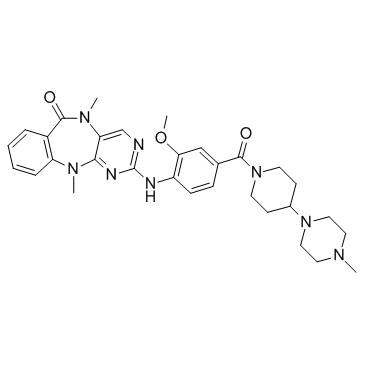1234480-84-2
| Name | 2-[2-methoxy-4-[4-(4-methylpiperazin-1-yl)piperidine-1-carbonyl]anilino]-5,11-dimethylpyrimido[4,5-b][1,4]benzodiazepin-6-one |
|---|---|
| Synonyms |
6H-Pyrimido[4,5-b][1,4]benzodiazepin-6-one, 5,11-dihydro-2-[[2-methoxy-4-[[4-(4-methyl-1-piperazinyl)-1-piperidinyl]carbonyl]phenyl]amino]-5,11-dimethyl-
LRRK2-IN-1 2-[(2-Methoxy-4-{[4-(4-methyl-1-piperazinyl)-1-piperidinyl]carbonyl}phenyl)amino]-5,11-dimethyl-5,11-dihydro-6H-pyrimido[4,5-b][1,4]benzodiazepin-6-one 2-((2-Methoxy-4-(4-(4-methylpiperazin-1-yl)piperidine-1-carbonyl)phenyl)amino)-5,11-dimethyl-5H-benzo[e]pyrimido[5,4-b][1,4]diazepin-6(11H)-one |
| Description | LRRK2-IN-1 is a potent and selective LRRK2 inhibitor with IC50 of 6 nM and 13 nM for LRRK2 (G2019S) and LRRK2 (WT), respectively. |
|---|---|
| Related Catalog | |
| Target |
IC50: 13 nM (WT), 6 nM (G2019S) |
| In Vitro | Wild-type and G2019S transduction results in 2.5 fold higher TR-FRET signal which can be inhibited by LRRK2-IN-1 in a dose-dependent manner with IC50 values of 0.08 µM and 0.03 µM, respectively[1]. LRRK2-IN-1 possessed an IC50 of 45 nM for inhibition of DCLK2 and exhibits an IC50 of greater than 1 µM when evaluated in biochemical assays for AURKB, CHEK2, MKNK2, MYLK, NUAK1, and PLK1. LRRK2-IN-1 is confirmed to inhibit MAPK7 with an EC50 of 160 nM. LRRK2-IN-1 induces a dose dependent inhibition of Ser910 and Ser935 phosphorylation accompanied by loss of 14-3-3 binding to both wild type LRRK2 and LRRK2[G2019S] stably transfected into HEK293 cells[2]. LRRK2-IN-1 is moderately cytotoxic with IC50 of 49.3 µM in HepG2 cells. LRRK2-IN-1 exhibits genotoxicity in the presence and absence of S9 at 15.6 and 3.9 µM, respectively[3]. LRRK2-IN-1 inhibits proliferation, migration, and induces cell death with hallmarks of apoptosis of HCT116 and AsPC-1 cells[4]. |
| In Vivo | LRRK2-IN-1 (100 mg/kg, i.p.) induces dephosphorylation of LRRK2 in the kidney of the mice[2]. Peritumoral injection of LRRK2-IN-1 (100 mg/kg) results in a significant decrease in tumor volume and weight of AsPC-1 tumor xenografts[4]. |
| Kinase Assay | Active GST-LRRK2 (1326-2527), GST-LRRK2 [G2019S] (1326-2527), GST-LRRK2 [A2016T] (1326-2527) and GST-LRRK2 [A2016T+G2019S] (1326-2527) enzyme is purified with glutathione sepharose from HEK293 cell lysate 36 h following transient transfection of the appropriate cDNA constructs. Peptide kinase assays, performed in duplicate, are set up in a total volume of 40 µL containing 0.5 µg LRRK2 kinase (which at approximately 10% purity gives a final concentration of 8 nM) in 50 mM Tris/HCl, pH 7.5, 0.1 mM EGTA, 10 mM MgCl2, 20 µM Nictide, 0.1 µM [γ-32P]ATP (500 cpm/pmol) and the indicated concentrations of inhibitor dissolved in DMSO. After incubation for 15 min at 30°C, reactions are terminated by spotting 35 µL of the reaction mix onto P81 phosphocellulose paper and immersion in 50 mM phosphoric acid. Samples are washed extensively and the incorporation of [γ-32P]ATP into Nictide is quantified by Cerenkov counting. IC50 values are calculated with GraphPad Prism using non-linear regression analysis. |
| Cell Assay | Cells (104 cells per well) are seeded into a 96-well tissue culture plate in triplicate. The cells are cultured in the presence of LRRK2-IN-1 with DMSO as a vehicle at 0, 0.31, 0.63, 1, 2, and 5, 10, and 20 μM. 48 h post treatment, 10 μL of TACS MTT Reagent is added to each well and the cells are incubated at 37°C until dark crystalline precipitate become visible in the cells. 100 μL of 266 mM NH4OH in DMSO is then added to the wells and placed on a plate shaker at low speed for 1 minute. After shaking, the plate is allowed to incubate for 10 minutes protected from light and the OD550 for each well is read using a microplate reader. The results are averaged and calculated as a percentage of the DMSO (vehicle) control +/- the standard error of the mean. |
| Animal Admin | LRRK2-IN-1 is dissolved in Captisol and administered by intraperitoneal injection into wild type male C57BL/6 mice at a dose of 100 mg/kg. Control mice are injected with an equal volume of Captisol. At 1 and 2 h time points, mice are extinguwashed by cervical dislocation and kidney and brain tissue rapidly dissected and snap-frozen in liquid nitrogen. |
| References |
| Density | 1.3±0.1 g/cm3 |
|---|---|
| Boiling Point | 787.8±70.0 °C at 760 mmHg |
| Molecular Formula | C31H38N8O3 |
| Molecular Weight | 570.685 |
| Flash Point | 430.3±35.7 °C |
| Exact Mass | 570.306702 |
| PSA | 100.76000 |
| LogP | 0.36 |
| Vapour Pressure | 0.0±2.7 mmHg at 25°C |
| Index of Refraction | 1.641 |
| Storage condition | 2-8℃ |
